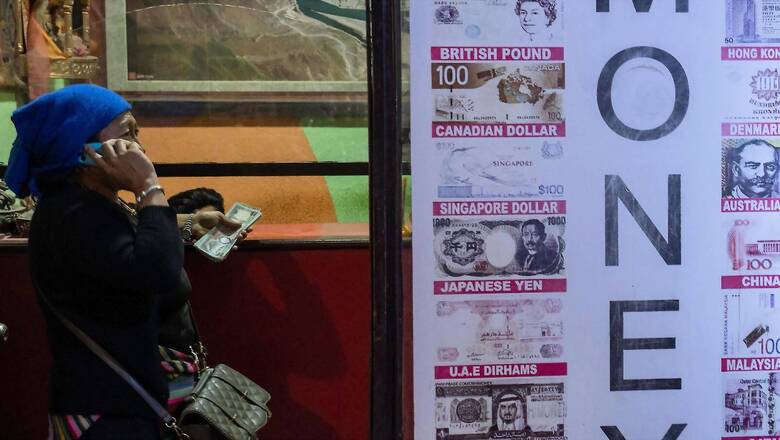
views
Even as India grapples with the economic crisis in Sri Lanka, another country is on the verge of facing a similar economic emergency in its vicinity. This time, it is our neighbour in the north, Nepal, which is showing classic symptoms of a brewing economic crisis. Nepal’s foreign exchange reserves have fallen by 18 per cent in mid-March since last July, enough to last for just six months of imports. Inflation in the country at 7 per cent is the highest in the last 67 months with crop loss due to last floods adding to its food-fuel inflation already exacerbated by the Ukraine-Russia war.
Government has imposed a ban on import of all luxury items such as cars, cosmetics, gold and silver among other things. It has also announced an additional holiday, reducing work week to a five-day schedule to tide over fuel shortage. In terms of external debt, Nepal is almost going Sri Lanka’s way with its debt-to-GDP ratio rising to 40 per cent in 2022 from 25 per cent in 2015. According to the government, all is well and opposition must stay clear of spreading rumors but when government projects a 6 per cent growth in its official Bureau of Statistics report when most independent experts are pegging it at 4 per cent maximum, it does become worrying in an election year.
While Sri Lanka and Nepal are recent cases of economic troubles, in our neighbourhood we have an IMF-addict whose 13th bailout plan has been put on hold by the IMF with other agencies such as the World Bank and the Asian Development Bank showing a similar pattern. Pakistan’s foreign exchange reserves are at the lowest of the low and won’t last beyond June. Its trade deficit stood at $39 billion, thanks to the populist policies of now-gone Imran Khan. So bad is the situation that the one of the first priorities of the new PM, Shehbaz Sharif, was to seek Saudi help over and above the loan of $4.2 billion that the Saudis have extended.
Another neighbour, Maldives, is also not in a safe position as among all the South Asian economies, oil imports constitute the highest part of its GDP with 20 per cent of its tourists coming from war-hit Russia and Ukraine.
Even before the pandemic, South Asia was already showing signs of weakening economies with the World Bank pointing this out in its 2019 report. Since 2014, South Asia enjoyed the tag of ‘world’s fastest growing region’ unchallenged until it lost to East Asia and the Pacific in 2019. While Sri Lanka and Nepal have COVID-19 as an excuse as both are tourism-dependent economy with a heavy reliance on remittances, Pakistan’s economy was in shambles even before the pandemic. According to the latest World Bank report on the region, South Asia is suffering from the twin-blow of COVID-19 pandemic and the Russia-Ukraine war. But that’s true only for the short and medium term.
In the long term, the economic crises that are erupting country after country in the region are a symptom of their structural failures. For instance, Sri Lanka’s woes are blamed on China but in reality, Chinese debt is just 10 per cent of the entire Sri Lankan debt. Similarly, blaming the debt accrued due to the China-Pakistan Economic Corridor for Pakistan’s economic troubles isn’t fair. Pakistan’s political economy is skewed in the favour of military and its favorite businessmen. Annual subsidy to the tune of Rs 1.3 trillion is extended to the big businesses and industries in the worst example of rewarding inefficiency world over. Also, the external debt that these countries have weren’t taken in just two years’ time.
External debt repayment to exports and remittances ratio is one of the highest in Pakistan and Sri Lanka. One of the glaring problems with these countries is their over-reliance on loans and remittances for foreign exchange because of their dismal export performance. All the three countries including Nepal, Pakistan and Sri Lanka have slumped in terms of their exports in the last two decades. Sri Lanka’s exports to GDP ratio fell to 16 per cent in 2022 from 39 per cent in 2000. Nepal’s exports to GDP ratio fell to 6.8 per cent from 23 per cent in 2000. In comparison to exports, the tourism sector has posted a slightly better performance for Nepal by contributing 7 per cent to its GDP. Pakistan’s exports to GDP ratio fell to 10 per cent from 15 per cent in 2003. In contrast, Bangladesh’s exports to GDP ratio has improved from 12 per cent in 2000 to 15 per cent in 2019.
The falling exports in the countries that are now experiencing troubles point to the clear need for restructuring the economies to become more efficient and focus on trade as a source of foreign exchange. The ever-widening trade deficits in these countries further highlight the need to curb non-essential imports and encourage domestic industries through the right tax policies and subsidies instead of appeasement. South Asia’s dependence on remittances and a few sectors such as tourism becomes especially worrying due to their debt-seeking behaviour. Ideally, these economies should emphasise prudent fiscal policies and diversification of exports but the elite’s preference for populism makes sure that bad politics triumphs over good economics.
The economic crises in certain South Asian economies may also ruin the image of the entire region for worse. Unlike Nepal, Pakistan and Sri Lanka, Bangladesh and India have focused on encouraging exports, boosting manufacturing and diversifying their export baskets. Both are in the process of signing a Comprehensive Economic Partnership Agreement to embark on joint manufacturing of defence equipment and medicines including vaccines. Their closer integration will benefit Bangladesh by providing it access to a key market like India and help India get connectivity to Bangladesh and beyond as a part of its Act East Policy.
While the problems that certain South Asian countries are facing are serious in nature but they must also accept that these are of their own making. The growing India-Bangladesh equation in the same region is a good example to follow, provided they look beyond the narrow lens of zero-sum games and geopolitical rivalries.
The author holds a PhD in International Relations from the Department of International Relations, South Asian University. Views expressed in this article are those of the author and do not represent the stand of this publication.
Read all the Latest Opinions here



















Comments
0 comment